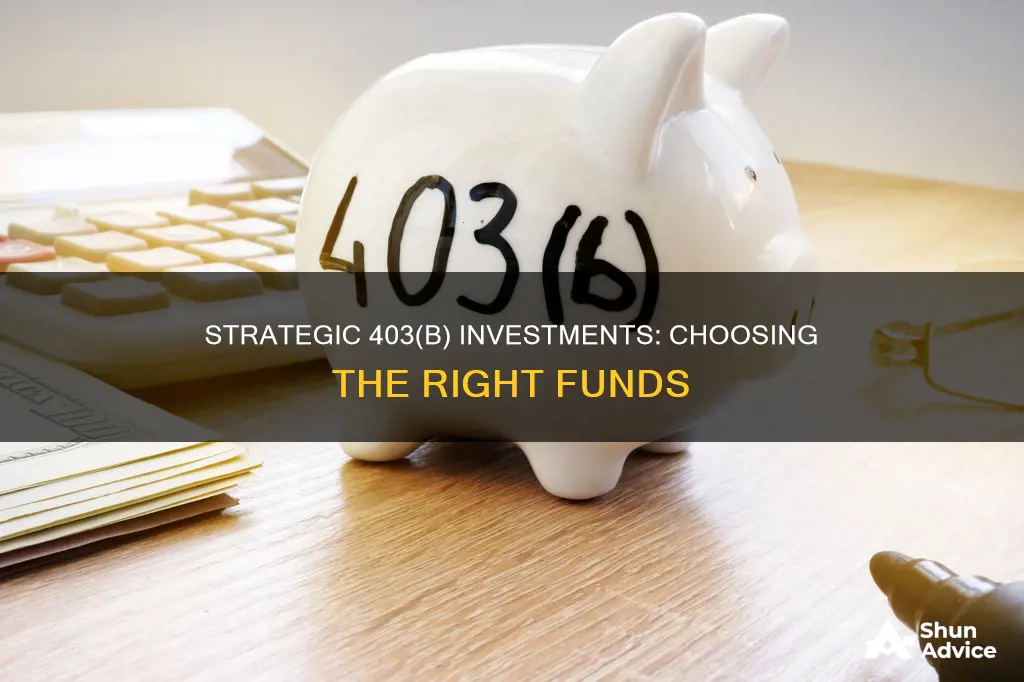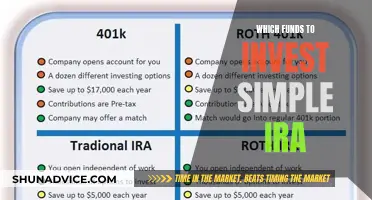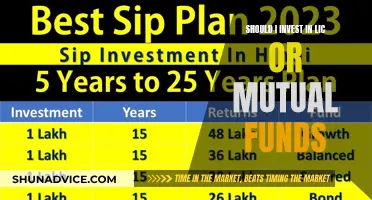
If you work in the public sector, you may be offered a 403(b) retirement plan. This is a type of retirement account available to individuals who work in public education and employees of certain tax-exempt organizations. Like a 401(k), a 403(b) account enables you to put aside a portion of each paycheck for your retirement, and your employer may match your contributions. A 403(b) may be either tax-deferred, meaning your contributions reduce your taxable income this year and you pay taxes on distributions in retirement, or a Roth 403(b), meaning you pay taxes on your contributions this year and your money grows tax-free afterward. So, what are the best funds to invest your 403(b) in?
| Characteristics | Values |
|---|---|
| Investment Options | Mutual funds, annuities, stocks, bonds, cash, target-date funds, index funds, exchange-traded funds (ETFs), real estate investment trusts (REITs) |
| Tax Advantages | Tax-deducted contributions, tax-free withdrawals (Roth 403(b)), tax-deferred growth |
| Contribution Limits | $22,500 for employees under 50 in 2023, $23,000 in 2024 |
| $30,000 for employees over 50 in 2023, $30,500 in 2024 (including catch-up contributions) | |
| $15,000 bonus catch-up contributions for employees with 15+ years of service | |
| Employer Contributions | May be offered, but less common than with 401(k) plans |
| Vesting Periods | Shorter or non-existent compared to 401(k) plans |
| Ideal For | Non-profit and government organization employees, including teachers, librarians |
What You'll Learn

Passive funds are cheaper
When it comes to investing your 403(b) plan, there are a few things to consider. 403(b) plans are tax-advantaged retirement plans, typically offered to employees at public schools, colleges, universities, and tax-exempt organisations like charities and churches. The contribution limits are the same as for 401(k) plans, and they offer participants a tax-advantaged way to save for retirement.
Now, when it comes to choosing the right investments for your 403(b) plan, there are two basic strategies: active investing and passive investing. Active investing involves trying to beat the market by predicting its movements and buying and selling accordingly. Passive investing, on the other hand, involves investing in funds that aim to make gains by mirroring the rises and falls of the market. Passive funds are generally cheaper, and here's why:
Firstly, passive funds require less active management. They are designed to mirror a specific market index or segment, so they don't require a fund manager to spend time researching and analysing investment opportunities. As a result, there are typically fewer fund managers and analysts needed to manage a passive fund, which leads to lower fees.
Secondly, passive funds benefit from ease of trade and transparency. Passive funds such as ETFs (exchange-traded funds) can be bought and sold at any time during the trading day, and they show all the underlying assets. They are also priced at regular intervals throughout the day. This level of transparency makes it easier for investors to understand what they are investing in and how their investments are performing.
Additionally, passive funds have lower expense ratios. Because they are not actively traded, there are fewer buying and selling costs associated with passive funds. This means that the percentage of your investment that you pay in fees is lower compared to actively managed funds.
Finally, passive funds offer lower capital gains taxes. Since passive investing is a long-term strategy, passive investors hold assets for longer periods, which results in paying less in taxes over time.
In summary, passive funds are generally cheaper than actively managed funds because they require less active management, have lower fees and expense ratios, and offer lower capital gains taxes due to their long-term nature. However, it's important to remember that passive investing may not always result in above-market returns, and there are certain niche markets where active investing may provide more opportunities.
Best Funds to Invest in Right Now
You may want to see also

Index funds for diversification
Index funds are a type of mutual or exchange-traded fund (ETF) that tracks the performance of a market index, such as the S&P 500, by holding the same stocks or bonds or a representative sample of them. They are defined as passive investments that mirror the performance of benchmarks like the S&P 500 by mimicking their makeup.
Index funds are a popular choice for investors seeking low-cost, diversified, and passive investments that tend to outperform many higher-fee, actively traded funds. They are ideal for long-term investing, such as retirement accounts, and are now a staple in many investment portfolios.
Low Fees and Expense Ratios:
Index funds are passively managed, meaning they aim to replicate the performance of a specific index without actively picking securities or timing the market. This passive management strategy results in lower fees and expense ratios compared to actively managed funds. Index funds often cost as low as 0.04%, while actively managed funds typically charge 0.44% or higher.
Broad Market Exposure and Diversification:
Index funds provide exposure to a diverse range of stocks or bonds across various sectors and asset classes, depending on their underlying index. For example, the S&P 500 index covers about 80% of all U.S. equities by market cap. By investing in an S&P 500 index fund, you gain access to a broad range of companies across different sectors, reducing the risk associated with individual stocks.
Historical Performance:
Over the long term, many index funds have outperformed actively managed funds, especially after accounting for fees and expenses. According to the S&P Indices Versus Active (SPIVA) scorecards, about 9 out of 10 actively managed funds didn't match the returns of the S&P 500 benchmark in the past 15 years.
Tax Efficiency:
Index funds have lower turnover rates, resulting in fewer capital gains distributions, making them more tax-efficient than actively managed funds.
Simplicity and Accessibility:
Index funds offer a simple, no-fuss way to gain exposure to a broad, diversified portfolio. They are suitable for beginners as well as expert investors. Additionally, they are easily accessible through online brokerage platforms or directly from fund companies.
When considering index funds for your 403(b) plan, it is important to remember that they are not a one-size-fits-all solution. The decision to invest in index funds should be based on your financial situation, goals, and risk tolerance. Consulting with a financial advisor can help you make informed investment decisions and ensure that your choices align with your overall financial objectives.
IRA Investment Funds: What You Need to Know
You may want to see also

Offer enough bond funds
When considering what funds to invest your 403(b) in, it is important to offer enough bond funds. Many participants will want at least some allocation to fixed income, but they may need different maturity structures to accomplish their objectives. Therefore, a single bond fund may not be suitable for all investors.
It is recommended to include short-term, intermediate, and long-term bond funds in your retirement plan to ensure participants have flexibility in building their asset allocation. Different investors may have different bond duration needs, so there is likely not a single, best fund for your 403(b) in this particular asset category.
The longer your investment horizon, the more weighted your portfolio should be towards stocks. Conversely, the closer you are to retirement, the more your portfolio should be weighted towards fixed investments. It is wise to reallocate your portfolio annually to meet your changing goals.
Target-date funds are mutual funds that automatically adjust their holdings to support you as you near your target retirement date. They can be a good option for automatic enrollment and are suitable for employees who have no interest in shifting their allocation over time. These funds are also helpful for new investors to get invested and stay invested, as they do the rebalancing and asset allocation shifts for the employees.
When considering bond funds, it is important to keep in mind the fees associated with them. Index funds that passively track established indexes tend to outperform their more actively managed counterparts, largely because they have significantly lower fees. A managed fund needs to charge more to compensate its professional money managers, whereas index fund managers have fewer decisions to make.
Oil Fund Investment: A Smart Move?
You may want to see also

Actively managed funds need vetting
Actively managed funds need additional vetting. If you opt for actively managed funds, prepare to do your research. There is an entire industry dedicated to selecting active managers, so be sure you are ready to take on this task. If you are ultimately responsible for the investments in your plan, you will need to understand what makes a particular actively managed fund desirable.
You may want to examine quantitative factors such as performance against peers and against an appropriate benchmark. You may also want to look at volatility and performance in down markets. But qualitative factors can be important, too. These include manager tenure, the management team's combined experience, and the team's investment process. Make sure you can justify the higher fees that typically come with actively managed funds. If you go the active route, be sure to document your selection criteria.
Be aware that active funds may not be as active as you think. If you decide to include actively managed funds in your retirement plan, watch out for "closet indexers". Some managers charge high active management fees but deliver a portfolio that looks suspiciously like the benchmark. You might as well just own the benchmark! A metric called "active share" can help you spot active managers who are not so active.
Mutual Fund Investment: A Smart SS Strategy?
You may want to see also

Target date funds for automatic enrolment
Target date funds (TDFs) are a good option for those who want to be automatically enrolled in a 403(b) plan. TDFs are diversified mutual funds that consist of stocks, bonds, and/or cash equivalent assets. They are designed to be a continuing post-retirement investment for older adults and are best suited for 403(b) plan participants who are inexperienced investors, do not pay attention to financial news, and desire a “low-maintenance” approach to retirement planning.
TDFs are based on the assumption that investors should have less stock and more fixed-income securities in their portfolio as they get older. They are also known as lifecycle and age-based funds. Investors typically select a fund with a date that matches or is close to their expected year of retirement. For example, an investor who is 30 years old and plans to retire at 65 might choose a target date fund with a target date of 2050.
TDFs are defined by their glide path, which is the planned schedule for changes in asset weightings over time as the fund approaches the target date and beyond. Glide paths are critical to TDF performance and vary among fund providers. There are two types of TDF glide paths: "to" and "through" retirement. A "to" glide path TDF assumes that the target date is the end of the slope and, from that point, the portfolio’s stock percentage weighting and investment mix remains static. A "through" glide path TDF continues to decrease the stock percentage for a designated number of years after the target date before levelling off.
TDFs can be a good option for automatic enrolment because they are designed to reduce the guesswork and maintenance involved in retirement planning. They are also a good default option for employees who do not want to select their own investments and are not interested in shifting their allocation over time. TDFs are also helpful for new investors to get invested and stay invested.
Target Date Funds: Charles Schwab Investment Strategies
You may want to see also







